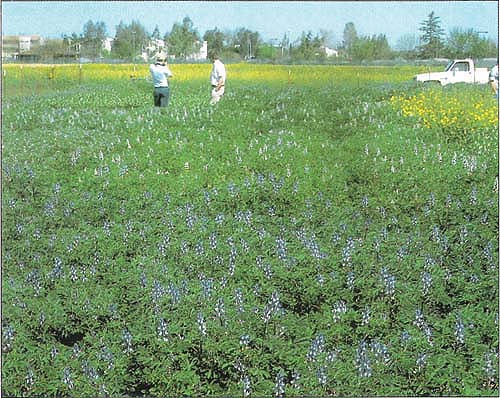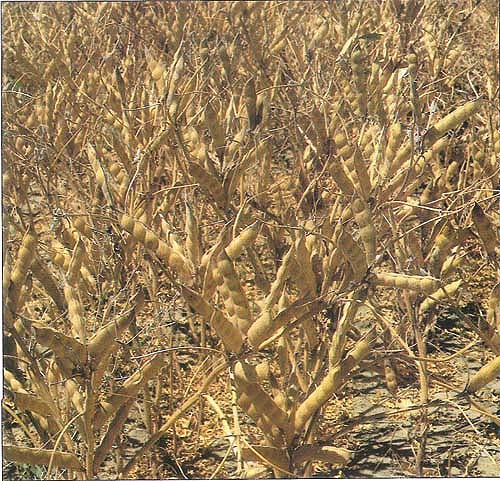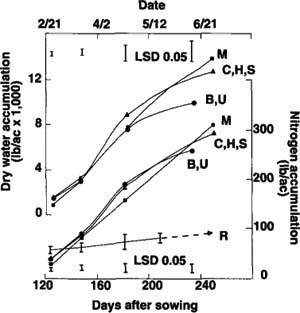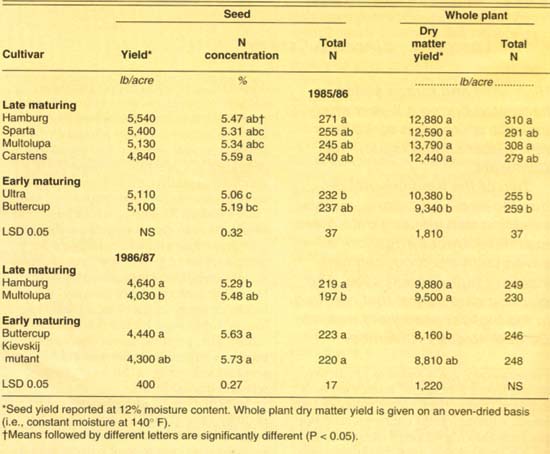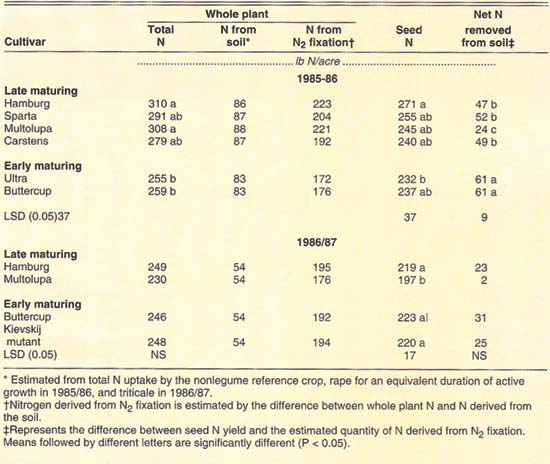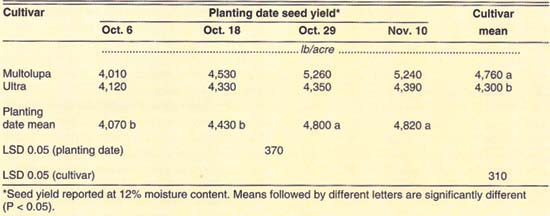All Issues
Competitive with soybean: White lupin could be new high-protein seed and forage for California
Publication Information
California Agriculture 46(2):17-19.
Published March 01, 1992
PDF | Citation | Permissions
Abstract
High seed and forage yields, harvested during a 2–year study, indicate white lupin could be a new winter annual legume for California. Two of the fundamental production-decision criteria, cultivar selection and planting date, were examined. Under irrigation, all seven cultivars produced high yields of high-protein seed. The planting date period that resulted in the highest seed yield was late October to early November.
Full text
Winter annual grain legumes are grown on less than 1% of the 6.7 million acres of irrigated land in the Central Valley of California. Although mild winters would not preclude the cultivation of many winter annual field crops, wheat and barley predominate as rotation breaks for higher value summer crops like cotton, rice and processing tomato. Lack of flexibility in selecting alternative winter annual crops limits economic return when cereal grain prices are low and may increase the tendency for repetitive monocropping with more profitable summer crops.
In Western Australia, which has a Mediterranean climate similar to that in California, grain lupin has recently become a major crop and now provides rotational diversity in large areas where rain-fed wheat was grown exclusively. Evidence suggests that wheat yields following lupin were higher than after wheat. This positive interaction was attributed to a reduction in disease and higher residual soil nitrogen (N) levels when wheat followed lupin.
In 1970, G. S. Gladstones, principal plant breeder at the Department of Agriculture, Western Australia, described the successful introduction of narrow-leafed lupin (Lupinus angustifolius L.) on the poor, sandy soils of Western Australia. He also noted that white lupin (Lupinus albus L.) performed better on more fertile soil. Gladstones' report and the availability of seed were the impetus to our investigation of white lupin on a fertile, irrigated soil at Davis, California.
Materials and methods
Cultivar comparison. White lupin cultivar comparison studies were conducted at the UC Davis Agronomy Farm during 1985-86 and 1986-87. Six cultivars in 1985-86, ‘Buttercup’, ‘Carstens’, ‘Hamburg’, ‘Multolupa’, ‘Sparta’ and ‘Ultra’, and four cultivars in 1986-87, ‘Buttercup’, ‘Hamburg’, ‘Kievskij Mutant’ and ‘Multolupa’, were evaluated for seed yield, dry matter yield and N yield. The experimental design was a completely randomized block with four replications. Each plot consisted of three 5-foot beds, 29 feet long. The field preparation and bed system were similar to those used for irrigated wheat, except no fertilizer was applied.
All lupin seeds were inoculated with Rhizobium lupini and sown six rows to a bed with a grain drill at 150 to 180 pounds per acre (lb/acre). The planting date was October 24 for both years. An herbicide combining Lorox (linuron) at 1 lb active ingredient (ai)/ac and Dual (metolachor) at 2 lb ai/ac was sprayed to control both broadleaf and grass weeds. The experiments were sprinkler irrigated after planting and subsequently sprinkler or furrow irrigated as needed.
Three dry matter harvests were taken during the 1985-86 season from 4.9-foot sections across the 5-foot beds. For both years, seed and final dry matter harvests were taken from 6.6-foot sections of the center beds.
Planting date. In 1986-87, the effect of planting date on seed yield and N yield was investigated using four planting dates spaced approximately 12 days apart beginning October 6. The design of the experiment was a split-plot with four replications: mainplots were planting dates and subplots were white lupin cultivars, ‘Multolupa’ and ‘Ultra’. Cultural practices and harvests were the same as described for the cultivar comparison experiment.
Results and discussion
Dry matter and nitrogen accumulation. White lupin grows extremely slowly when sown as a winter annual. Four months after planting the average dry matter, N accumulation was approximately one-tenth the dry matter. One-eighth the N accrued 4 months later at maturity (fig. 1). Because of this slow growth habit and nearly linear N uptake, the largest dry matter and N accumulations occurred at maturity. Thus, it appears most advantageous to harvest lupin as silage near physiological maturity to obtain highest dry matter and N yields.
Fig. 1. Whole-plant aboveground dry matter and N accumulation of irrigated and rhizobia-inoculated white lupin cultivars: Multolupa (M); Carstens, Hamburg and Sparta (C,H,S); Buttercup and Ultra (B,U). Nitrogen accumulation by nonlegume reference rape crop (R) was estimated by linear regression of N accumulation sample date (—) and projected to physiological maturity of the lupin cultivars (—). Vertical intervals through means of rape N accumulation values represent ± SE, while bar intervals at top and bottom indicate LSD (0.05) for dry matter and N accumulation, respectively.
At seed harvest, the late-maturing cultivars (cultivars which matured up to 2 weeks later than early-maturing cultivars) amassed greater whole plant yield and, with one exception, accumulated greater total plant N than early maturing cultivars (table 1). Therefore, the late-maturing cultivars appear to be better choices for lupin silage.
Seed yield and N content. With irrigated seed yield ranging from 4,030 to 5,540 lb/ac (table 1) and containing 32 to 36% protein (%N x 6.25), the future of white lupin as a high-protein grain legume in California is very promising. High seed yield combined with high N concentration resulted in an average seed N yield of 234 lb/ac, which compares favorably with soybean. Of the 11 grain legumes reported by the Food and Agriculture Organization, lupin ranked second only to soybean in seed N yield.
These high seed and N yields were achieved despite the over 2.5-fold difference in November to June precipitation between the two study years. The importance of irrigation for these studies in maintaining high yields is supported by reports of low or variable seed production under rainfed conditions.
TABLE 1. Yield and N content of seed and whole plant of white lupin cultivars inoculated with Rhizobium lupini, UC Davis, 1985/86 and 1986/87
‘Hamburg’ ranked highest in seed yield and total crop N over both years. However, the performance of ‘Hamburg’ was seldom significantly greater than the other cultivars. The high yields obtained by all cultivars in these studies attest to the suitability of white lupin as a winter grain legume for the Central Valley.
Nitrogen balance. Whole plant N of the lupin cultivars came from N derived from the soil and the atmosphere, that is, from its symbiotic relationship with the nodular bacteria, Rhizobium lupini. Available soil N was estimated by total plant N uptake of the nonlegume crops, rape and triticale. Nitrogen fixation was estimated as the difference between whole plant N of the lupin cultivars and soil N.
TABLE 2. Nitrogen balance for irrigated and Rhizobium Iupini-inoculated white lupin cultivars based on seed harvest and return of haulms, UC Davis 1985/86 and 1986/87
TABLE 3. Seed yield from four planting dates of two irrigated white lupin cultivars inoculated with Rhizobium lupini, UC Davis, 1986/87
The mean nitrogen fixation was very high, 195 lb/ac (table 2), which places white lupin among the leading nitrogen-fixing crops. However, the N removed in seed with seed harvest was greater than the quantity of N derived from nitrogen fixation. Therefore, even with the incorporation of haulms (lupin residue), seed harvest resulted in an estimated net depletion of soil N. Soil N depletion after seed harvest was significantly greater for early-maturing cultivars than for late-maturing cultivars in 1985-86, due in part to the significantly lower N returned with haulm incorporation of early maturing cultivars. Although harvesting lupin for seed will not apparently increase the soil N, lupin does not require high rates of N fertilization for achieving high yields, as do nonfixing crops such as cereals.
Planting date. Seed yield of the two later planting dates, October 29 and November 10, were significantly greater than the two earlier planting dates, October 6 and October 18 (table 3). The last two planting dates also produced significantly greater whole plant N and seed N yields (data not shown).
Although seed and N yields of the November 10 planting date were as high or higher than the October 29 planting date, the planting season was unusually warm. Degree-day summations for one month following each planting date were 9 to 19% greater than the 20-year mean for this area. Therefore, under more normal conditions, planting in or near the last week of October may prove to be better than waiting until November.
Conclusion
The high seed and N yields achieved in these studies demonstrate the potential of white lupin as an irrigated winter annual legume crop for California. The cultivation of white lupin would provide both rotational and market diversity, while utilizing existing small grain machinery. The high-protein seed of lupin could propel many California growers into a new market, that of high-protein meal. This market is currently dominated by soybean, but lupin seed with its high-protein quality and quantity is competitive with soybean.
In these studies N removed with seed harvest was not fully compensated for by nitrogen fixation. At the end of the season the soil was slightly N depleted, but the rhizobia-inoculated seed used in these studies did not receive N fertilization to achieve these high-protein seed yields.
Two important agronomic considerations were investigated, cultivar comparison and planting date. We found that all cultivars performed well, with ‘Hamburg’ having a slight advantage, and late October appeared to be the most appropriate planting date. However, these are only two tentative suggestions for irrigated white lupin cultivation. Before recommendations on the cultivation of lupin can be made with confidence, additional studies are necessary.



